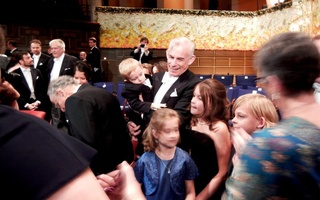In the spring of 1960, 1,359 members of the Harvard faculty signed a petition encouraging the Eisenhower administration to consider banning nuclear testing in the United States, according to a Crimson article from May 16 of the same year. The petition, which was telegraphed to Washington, preceded an upsurge in student and faculty interest in arms control that continued into the decade.
According to the Crimson article, after 24 faculty members signed the petition, it was mailed to about 4,000 Harvard Corporation appointees, which included consultants in addition to faculty members. Ninety percent of those who responded added their names to the petition.
TESTING FALLOUT
Throughout the 1950s, the United States had conducted a series of nuclear tests, most of which initially occurred underground. Concerns arose when some larger weapons were tested in the open atmosphere over the Pacific Ocean. On March 1, 1954, a Japanese fishing boat was exposed to nuclear fallout, killing the captain and wounding the other 22 crew members.
According to History of Science Professor Everett Mendelsohn, who said he had supported the faculty petition, the concerns about testing were twofold. “One was that the increased input of radiation into the atmosphere could be harmful,” he said.
Physics Professor Roy J. Glauber ’45—who said he did not remember the faculty petition—also said that testing thermonuclear weapons could be dangerous.
“The thermonuclear weapons were generally tested in the open air, and that was subjecting everybody downwind from them to the danger of fallout,” he said. “And when I say downwind I mean high altitude winds that carry the cloud clear around the globe several times.”
According to Mendelsohn, “the second and most compelling” argument for a test ban was that nuclear testing increased tension between the United States and the Soviet Union, which was also testing nuclear weapons at the time. Mendelsohn said each nation would respond to the other’s tests by trying to do something “bigger or better.”
“If testing went on, it seemed inevitable that other countries would get their own nuclear deterrents,” he said.
SEEDS OF ACTIVISM
For some Harvard students, the appearance of the petition in the spring of 1960 barely caused a stir.
“In the early 60s, the issue didn’t loom large in student life,” Mendelsohn said. “I’d say for many students, nuclear testing was somewhat esoteric.”
An article printed in the 1960 Commencement supplement of The Crimson made note of the relative lack of political activity on campus, calling students “uninspired.”
But according to Todd A. Gitlin ’63, arms control had become a “roaring issue” by that fall.
October brought the first meeting of a new student group called Tocsin—a word meaning “alarm bell” that has also been a code name in several military nuclear strike events—whose primary activities involved spreading awareness and promoting the fight against nuclear arms and testing.
Read more in News
Bunting Strengthens Harvard-Radcliffe TiesRecommended Articles
-
 Panel Talks About Occupy Boston
Panel Talks About Occupy Boston -
Tocsin Brings Harvard to Forefront of Student MovementFounded a decade before activism on campus peaked with the 1969 takeover of University Hall, Tocsin signaled of the start of Harvard’s student movement.
-
 Chris Sims '63: Mathematician, Economist, and Many Things In-Between
Chris Sims '63: Mathematician, Economist, and Many Things In-Between -
 Ted Kennedy '54-'56 Went To The Senate In 1962, But Not With Harvard's Support
Ted Kennedy '54-'56 Went To The Senate In 1962, But Not With Harvard's Support -
 Cuban Missile Crisis of October 1962 Shocks Campus
Cuban Missile Crisis of October 1962 Shocks Campus













